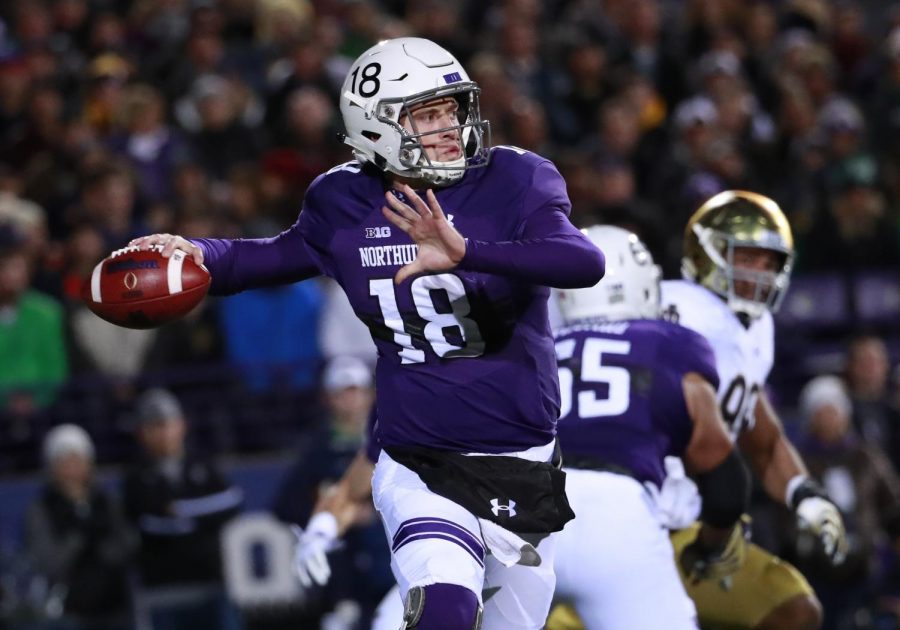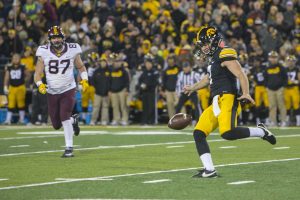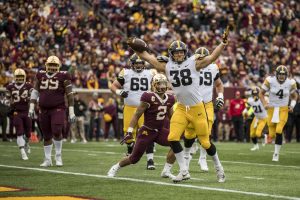By the numbers: Northwestern
Northwestern Wildcats quarterback Clayton Thorson (18) throws a pass during the first half against the Notre Dame Fighting Irish at Ryan Field in Evanston, Ill., on Saturday, Nov. 31, 2018. Notre Dame won, 31-21. (Nuccio DiNuzzo/Chicago Tribune/TNS)
November 9, 2018
Northwestern is no longer a dark horse to win the Big Ten West. With only three games left, it’s moving closer and closer to that prize.
After losing three straight following an opening win against Purdue, Northwestern has gone 4-1 with two Big Ten upsets.
On paper, in comparison to a generalization of the opponents they have faced so far, the Wildcats use an increase in passing yards to make up for a lack of a running game and collect fewer penalties than every team they’ve faced. However, when their quarterback isn’t on his game, opponents have been able to gain ground on interceptions.
26-45: Northwestern’s penalties & yards
Northwestern plays by the rules.
This season, no opponents have recorded fewer penalties than the Wildcats in a game. Only twice has Northwestern had a season-high six penalties in a game — against Purdue (56 yards) and Rutgers (49 yards).
Against Akron, Michigan State, and Wisconsin, Northwestern lost a combined total of only 80 yards on three penalties per game. Against Duke and Michigan, it lost 20 and 25 yards, respectively, on two penalties.
The Wildcats had only one penalty against Nebraska for a loss of 5 yards, and most recently against Notre Dame, no flags were thrown and recorded against the Purple and White.
The dearth of penalties shows that either Northwestern knows how to hide its wrongdoings extremely well or the entire team plays strictly by the book and is experienced enough to finish plays the right way.
2,382: Wildcat passing yards
If Northwestern moves the ball, most of the time it comes through the air.
The Wildcats have more than 200 passing yards than their opponents thus far but have fewer than 400 rushing yards. Northwestern’s 837 rushing yards don’t compare with Iowa’s 1,411.
However, when it does run the ball, Northwestern’s goal is to take it in for the score. Seventeen of its touchdowns have come on the ground, compared with 11 passing.
Quarterback Clayton Thorson has thrown for the majority of the passing yards and a 60 percent completion rate.
Former running back Jeremy Larkin remains the Wildcats’ leader in rushing yards this season (353) despite retiring from football in late September because of medical reasons. Next up is Isaiah Bowser, who has collected 327 yards in six games.
11: Interceptions
If Iowa’s coverage can get turned around toward the ball instead of collecting pass-interference calls, Northwestern’s offense-turned-defense allows yards on interceptions.
Opponents have an average of 17.5 yards returning interceptions against the Wildcats this season. Thorson has thrown 10 in his nine games, and 193 yards have come on 11 interceptions.
In three games this season, Thorson has 2 interceptions, and he threw for 3 in the win against Wisconsin. In all three games with 2 interceptions, he also threw for 3 touchdowns.
On the other side, Northwestern has only run the ball back on 6 interceptions for a total of 60 yards.






